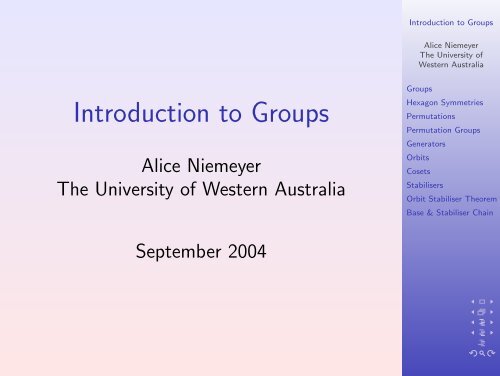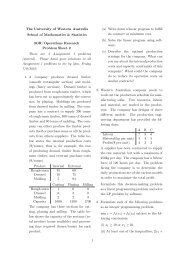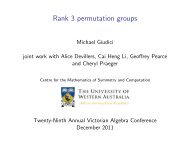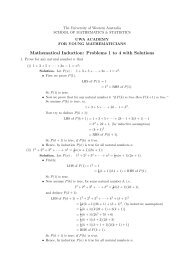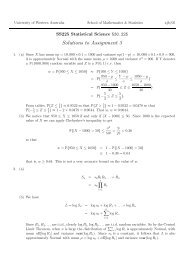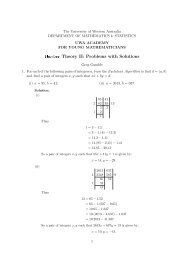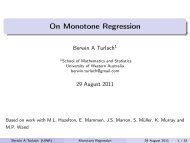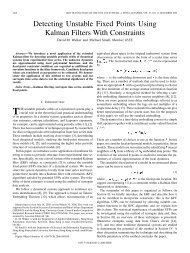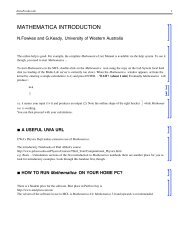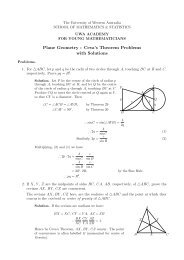Introduction to Groups - The University of Western Australia
Introduction to Groups - The University of Western Australia
Introduction to Groups - The University of Western Australia
- No tags were found...
Create successful ePaper yourself
Turn your PDF publications into a flip-book with our unique Google optimized e-Paper software.
<strong>Introduction</strong> <strong>to</strong> <strong>Groups</strong>Alice Niemeyer<strong>The</strong> <strong>University</strong> <strong>of</strong><strong>Western</strong> <strong>Australia</strong><strong>Introduction</strong> <strong>to</strong> <strong>Groups</strong>Alice Niemeyer<strong>The</strong> <strong>University</strong> <strong>of</strong> <strong>Western</strong> <strong>Australia</strong><strong>Groups</strong>Hexagon SymmetriesPermutationsPermutation <strong>Groups</strong>Genera<strong>to</strong>rsOrbitsCosetsStabilisersOrbit Stabiliser <strong>The</strong>oremBase & Stabiliser ChainSeptember 2004
<strong>Introduction</strong> <strong>to</strong> <strong>Groups</strong>Alice Niemeyer<strong>The</strong> <strong>University</strong> <strong>of</strong><strong>Western</strong> <strong>Australia</strong>DefinitionA group (G, ∗) is abelian if the binaryoperation ∗ is commutative.<strong>Groups</strong>Hexagon SymmetriesPermutationsPermutation <strong>Groups</strong>Genera<strong>to</strong>rsOrbitsCosetsStabilisersOrbit Stabiliser <strong>The</strong>oremBase & Stabiliser Chain
Examples<strong>Introduction</strong> <strong>to</strong> <strong>Groups</strong>Alice Niemeyer<strong>The</strong> <strong>University</strong> <strong>of</strong><strong>Western</strong> <strong>Australia</strong>1. (Z, +), (Q, +), (R, +), (C, +) aregroups.2. (Q\{0}, ·), (R\{0}, ·), (C\{0}, ·) aregroups.3. (R n , +), the set <strong>of</strong> vec<strong>to</strong>rs in R n undervec<strong>to</strong>r addition, is a group.<strong>Groups</strong>Hexagon SymmetriesPermutationsPermutation <strong>Groups</strong>Genera<strong>to</strong>rsOrbitsCosetsStabilisersOrbit Stabiliser <strong>The</strong>oremBase & Stabiliser Chain
More Examples<strong>Introduction</strong> <strong>to</strong> <strong>Groups</strong>Alice Niemeyer<strong>The</strong> <strong>University</strong> <strong>of</strong><strong>Western</strong> <strong>Australia</strong>4. (M n (R), ∗), the set <strong>of</strong> n × n matriceswith entries in R under matrixmultiplication, is not a group.5. (GL n (R), ∗), the set <strong>of</strong> invertible n × nmatrices with entries in R under matrixmultiplication, is a group. This group iscalled the general linear group over R.This group is not abelian.<strong>Groups</strong>Hexagon SymmetriesPermutationsPermutation <strong>Groups</strong>Genera<strong>to</strong>rsOrbitsCosetsStabilisersOrbit Stabiliser <strong>The</strong>oremBase & Stabiliser Chain
¡ ¡¡ ¡¨¨¨¨¨¨Symmetries <strong>of</strong> a HexagonRotation:6¢ ¢ £ £¢ £ £ ¢£ £ ¢ ¢¡ ¡12<strong>Introduction</strong> <strong>to</strong> <strong>Groups</strong>Alice Niemeyer<strong>The</strong> <strong>University</strong> <strong>of</strong><strong>Western</strong> <strong>Australia</strong><strong>Groups</strong>Hexagon SymmetriesPermutationsPermutation <strong>Groups</strong>Genera<strong>to</strong>rsOrbitsCosetsStabilisersOrbit Stabiliser <strong>The</strong>oremBase & Stabiliser Chain5¤ ¤ ¥ ¥¤ ¥ ¤ ¥¥ ¥ ¤ ¤¦ ¦ § §¦ § ¦ §§ § ¦ ¦3© ©4© ©© ©
¡ ¡¡ ¡¨¨¨¨¨¨Symmetries <strong>of</strong> a HexagonRotation:6¢ ¢ £ £¢ £ £ ¢£ £ ¢ ¢¡ ¡12<strong>Introduction</strong> <strong>to</strong> <strong>Groups</strong>Alice Niemeyer<strong>The</strong> <strong>University</strong> <strong>of</strong><strong>Western</strong> <strong>Australia</strong><strong>Groups</strong>Hexagon SymmetriesPermutationsPermutation <strong>Groups</strong>Genera<strong>to</strong>rsOrbitsCosetsStabilisersOrbit Stabiliser <strong>The</strong>oremBase & Stabiliser Chain5¤ ¤ ¥ ¥¤ ¥ ¤ ¥¥ ¥ ¤ ¤¦ ¦ § §¦ § ¦ §§ § ¦ ¦3© ©4© ©© ©
¡ ¡¡ ¡¨¨¨¨¨¨Symmetries <strong>of</strong> a HexagonRotation:5¡ ¡6¢ ¢ £ £¢ £ ¢ ££ £ ¢ ¢1621<strong>Introduction</strong> <strong>to</strong> <strong>Groups</strong>Alice Niemeyer<strong>The</strong> <strong>University</strong> <strong>of</strong><strong>Western</strong> <strong>Australia</strong><strong>Groups</strong>Hexagon SymmetriesPermutationsPermutation <strong>Groups</strong>Genera<strong>to</strong>rsOrbitsCosetsStabilisersOrbit Stabiliser <strong>The</strong>oremBase & Stabiliser Chain4¤ ¤ ¥ ¥¤ ¥ ¤ ¥¥ ¥ ¤ ¤53¦ ¦ § §¦ § ¦ §§ § ¦ ¦24© ©© ©3© ©
¡ ¡¡ ¡¨¨¨¨¨¨Reflectionsline through opposite vertices:6¢ ¢ £ £¢ £ £ ¢£ £ ¢ ¢¡ ¡12<strong>Introduction</strong> <strong>to</strong> <strong>Groups</strong>Alice Niemeyer<strong>The</strong> <strong>University</strong> <strong>of</strong><strong>Western</strong> <strong>Australia</strong><strong>Groups</strong>Hexagon SymmetriesPermutationsPermutation <strong>Groups</strong>Genera<strong>to</strong>rsOrbitsCosetsStabilisersOrbit Stabiliser <strong>The</strong>oremBase & Stabiliser Chain5¤ ¤ ¥ ¥¤ ¥ ¤ ¥¥ ¥ ¤ ¤¦ ¦ § §¦ § ¦ §§ § ¦ ¦3© ©4© ©© ©
¡ ¡¡ ¡¨¨¨¨¨¨Reflectionsline through opposite vertices:6¢ ¢ £ £¢ £ £ ¢£ £ ¢ ¢¡ ¡12<strong>Introduction</strong> <strong>to</strong> <strong>Groups</strong>Alice Niemeyer<strong>The</strong> <strong>University</strong> <strong>of</strong><strong>Western</strong> <strong>Australia</strong><strong>Groups</strong>Hexagon SymmetriesPermutationsPermutation <strong>Groups</strong>Genera<strong>to</strong>rsOrbitsCosetsStabilisersOrbit Stabiliser <strong>The</strong>oremBase & Stabiliser Chain5¤ ¤ ¥ ¥¤ ¥ ¤ ¥¥ ¥ ¤ ¤¦ ¦ § §¦ § ¦ §§ § ¦ ¦3© ©4© ©© ©
¡ ¡¡ ¡¨¨¨¨¨¨Reflectionsline through opposite vertices:2¢ ¢ £ £¢ £ £ ¢£ £ ¢ ¢¡ ¡61126<strong>Introduction</strong> <strong>to</strong> <strong>Groups</strong>Alice Niemeyer<strong>The</strong> <strong>University</strong> <strong>of</strong><strong>Western</strong> <strong>Australia</strong><strong>Groups</strong>Hexagon SymmetriesPermutationsPermutation <strong>Groups</strong>Genera<strong>to</strong>rsOrbitsCosetsStabilisersOrbit Stabiliser <strong>The</strong>oremBase & Stabiliser Chain5 3¤ ¥ ¥ ¤¦ § § ¦3¤ ¥ ¥ ¤¦ § § ¦5¤ ¥ ¥ ¤¦ § § ¦4© ©© ©4© ©
¡ ¡¡ ¡¨¨¨¨¨¨Reflectionsline through opposite edges:6¢ ¢ £ £¢ £ £ ¢£ £ ¢ ¢¡ ¡12<strong>Introduction</strong> <strong>to</strong> <strong>Groups</strong>Alice Niemeyer<strong>The</strong> <strong>University</strong> <strong>of</strong><strong>Western</strong> <strong>Australia</strong><strong>Groups</strong>Hexagon SymmetriesPermutationsPermutation <strong>Groups</strong>Genera<strong>to</strong>rsOrbitsCosetsStabilisersOrbit Stabiliser <strong>The</strong>oremBase & Stabiliser Chain5¤ ¤ ¥ ¥¤ ¥ ¤ ¥¥ ¥ ¤ ¤¦ ¦ § §¦ § ¦ §§ § ¦ ¦3© ©4© ©© ©
¡ ¡¡ ¡¨¨¨¨¨¨Reflectionsline through opposite edges:3¡ ¡2¢ ¢ £ £¢ £ ¢ ££ £ ¢ ¢1621<strong>Introduction</strong> <strong>to</strong> <strong>Groups</strong>Alice Niemeyer<strong>The</strong> <strong>University</strong> <strong>of</strong><strong>Western</strong> <strong>Australia</strong><strong>Groups</strong>Hexagon SymmetriesPermutationsPermutation <strong>Groups</strong>Genera<strong>to</strong>rsOrbitsCosetsStabilisersOrbit Stabiliser <strong>The</strong>oremBase & Stabiliser Chain4¤ ¤ ¥ ¥¤ ¥ ¤ ¥¥ ¥ ¤ ¤53¦ ¦ § §¦ § ¦ §§ § ¦ ¦64© ©© ©5© ©
Permutations<strong>Introduction</strong> <strong>to</strong> <strong>Groups</strong>Alice Niemeyer<strong>The</strong> <strong>University</strong> <strong>of</strong><strong>Western</strong> <strong>Australia</strong>Ω finite set. A permutation <strong>of</strong> Ω is a 1-1and on<strong>to</strong> function from Ω <strong>to</strong> Ω.<strong>The</strong> image <strong>of</strong> b ∈ Ω under a permutation gis denoted b g .<strong>Groups</strong>Hexagon SymmetriesPermutationsPermutation <strong>Groups</strong>Genera<strong>to</strong>rsOrbitsCosetsStabilisersOrbit Stabiliser <strong>The</strong>oremBase & Stabiliser Chain
¡ ¡¡ ¡¡ ¡¨¨¨¨¨¨Disjoint Cycle Notation<strong>Introduction</strong> <strong>to</strong> <strong>Groups</strong>Alice Niemeyer<strong>The</strong> <strong>University</strong> <strong>of</strong><strong>Western</strong> <strong>Australia</strong>Consider again the reflection through theline passing through 1 and 4 <strong>of</strong> the hexagon.1( )£ ¢ £ ¢£ £ ¢ ¢£ £ ¢ ¢11 2 3 4 5 66 1 6 5 4 3 22621234<strong>Groups</strong>Hexagon SymmetriesPermutationsPermutation <strong>Groups</strong>Genera<strong>to</strong>rsOrbitsCosetsStabilisersOrbit Stabiliser <strong>The</strong>oremBase & Stabiliser Chain35 3¤ ¤ ¥ ¥¦ § § ¦¥ ¤ ¦ ¤¦ § §¥§ § ¦ ¦ ¥ ¥ ¤ ¤© ©© ©© ©4456(1)(2, 6)(3, 5)(4)5
Conventions<strong>Introduction</strong> <strong>to</strong> <strong>Groups</strong>Alice Niemeyer<strong>The</strong> <strong>University</strong> <strong>of</strong><strong>Western</strong> <strong>Australia</strong>I () denotes the identity permutation.I g k denotes g · g · · · g .} {{ }kI Cycles with just one point are omitted.<strong>Groups</strong>Hexagon SymmetriesPermutationsPermutation <strong>Groups</strong>Genera<strong>to</strong>rsOrbitsCosetsStabilisersOrbit Stabiliser <strong>The</strong>oremBase & Stabiliser ChainExample(1)(2, 6)(3, 5)(4) is written as (2, 6)(3, 5).
Order <strong>of</strong> a Permutation<strong>Introduction</strong> <strong>to</strong> <strong>Groups</strong>Alice Niemeyer<strong>The</strong> <strong>University</strong> <strong>of</strong><strong>Western</strong> <strong>Australia</strong>Let g be a permutation on n points.<strong>The</strong> order <strong>of</strong> g is the smallest m such thatg m = (). Notation o(g).<strong>Groups</strong>Hexagon SymmetriesPermutationsPermutation <strong>Groups</strong>Genera<strong>to</strong>rsOrbitsCosetsStabilisersOrbit Stabiliser <strong>The</strong>oremBase & Stabiliser Chain
Order <strong>of</strong> a Permutation<strong>Introduction</strong> <strong>to</strong> <strong>Groups</strong>Alice Niemeyer<strong>The</strong> <strong>University</strong> <strong>of</strong><strong>Western</strong> <strong>Australia</strong><strong>The</strong>orem (Ruffini 1799)<strong>The</strong> order <strong>of</strong> a permutation in disjoint cyclenotation is the least common multiple <strong>of</strong> thecycle lengths.<strong>Groups</strong>Hexagon SymmetriesPermutationsPermutation <strong>Groups</strong>Genera<strong>to</strong>rsOrbitsCosetsStabilisersOrbit Stabiliser <strong>The</strong>oremBase & Stabiliser Chain
Order <strong>of</strong> a Permutation<strong>Introduction</strong> <strong>to</strong> <strong>Groups</strong>Alice Niemeyer<strong>The</strong> <strong>University</strong> <strong>of</strong><strong>Western</strong> <strong>Australia</strong><strong>The</strong>orem (Ruffini 1799)<strong>The</strong> order <strong>of</strong> a permutation in disjoint cyclenotation is the least common multiple <strong>of</strong> thecycle lengths.Exampleo((2, 6)(3, 5)) = lcm(2, 2) = 2.<strong>Groups</strong>Hexagon SymmetriesPermutationsPermutation <strong>Groups</strong>Genera<strong>to</strong>rsOrbitsCosetsStabilisersOrbit Stabiliser <strong>The</strong>oremBase & Stabiliser Chain
Cycle StructureExample for Ω = {1, . . . , 12}:g = (1, 3, 4)(2, 5, 7)(6, 8, 11, 10)(9, 12)has one cycle <strong>of</strong> length 2, two cycles <strong>of</strong>length 3 and one cycle <strong>of</strong> length 4.<strong>Introduction</strong> <strong>to</strong> <strong>Groups</strong>Alice Niemeyer<strong>The</strong> <strong>University</strong> <strong>of</strong><strong>Western</strong> <strong>Australia</strong><strong>Groups</strong>Hexagon SymmetriesPermutationsPermutation <strong>Groups</strong>Genera<strong>to</strong>rsOrbitsCosetsStabilisersOrbit Stabiliser <strong>The</strong>oremBase & Stabiliser ChainCyc(g) = 1 0 2 1 3 2 4 1 5 0 · · · 12 0 .
Cycle Structure<strong>Introduction</strong> <strong>to</strong> <strong>Groups</strong>Alice Niemeyer<strong>The</strong> <strong>University</strong> <strong>of</strong><strong>Western</strong> <strong>Australia</strong>If g has α i cycles <strong>of</strong> length i we say g hascycle structure1 α 12 α2 · · · n α n.<strong>Groups</strong>Hexagon SymmetriesPermutationsPermutation <strong>Groups</strong>Genera<strong>to</strong>rsOrbitsCosetsStabilisersOrbit Stabiliser <strong>The</strong>oremBase & Stabiliser Chain
Conjugate PermutationsLet g and h be permutations on Ω. <strong>The</strong>nh −1 gh is the conjugate <strong>of</strong> g by h.Notation: g h .If a g = b then(a h ) h−1 gh= b h .<strong>Introduction</strong> <strong>to</strong> <strong>Groups</strong>Alice Niemeyer<strong>The</strong> <strong>University</strong> <strong>of</strong><strong>Western</strong> <strong>Australia</strong><strong>Groups</strong>Hexagon SymmetriesPermutationsPermutation <strong>Groups</strong>Genera<strong>to</strong>rsOrbitsCosetsStabilisersOrbit Stabiliser <strong>The</strong>oremBase & Stabiliser Chain
Conjugate PermutationsLet g and h be permutations on Ω. <strong>The</strong>nh −1 gh is the conjugate <strong>of</strong> g by h.Notation: g h .a 6a 1ga 2ha 6ha 1g hha 2<strong>Introduction</strong> <strong>to</strong> <strong>Groups</strong>Alice Niemeyer<strong>The</strong> <strong>University</strong> <strong>of</strong><strong>Western</strong> <strong>Australia</strong><strong>Groups</strong>Hexagon SymmetriesPermutationsPermutation <strong>Groups</strong>Genera<strong>to</strong>rsOrbitsCosetsStabilisersOrbit Stabiliser <strong>The</strong>oremBase & Stabiliser Chaina 5a 3ha 5ha 3a 4 a 4h
Conjugate PermutationsLet g and h be permutations on Ω. <strong>The</strong>nh −1 gh is the conjugate <strong>of</strong> g by h.Notation: g h .LemmaConjugate permutations have the same cyclestructure.<strong>Introduction</strong> <strong>to</strong> <strong>Groups</strong>Alice Niemeyer<strong>The</strong> <strong>University</strong> <strong>of</strong><strong>Western</strong> <strong>Australia</strong><strong>Groups</strong>Hexagon SymmetriesPermutationsPermutation <strong>Groups</strong>Genera<strong>to</strong>rsOrbitsCosetsStabilisersOrbit Stabiliser <strong>The</strong>oremBase & Stabiliser Chain
Conjugate PermutationsLet g and h be permutations on Ω. <strong>The</strong>nh −1 gh is the conjugate <strong>of</strong> g by h.Notation: g h .Example(1, 2, 5)(7, 3, 6) (1,7)(2,6)= (7, 6, 5)(1, 3, 2)= (5, 7, 6)(1, 3, 2).<strong>Introduction</strong> <strong>to</strong> <strong>Groups</strong>Alice Niemeyer<strong>The</strong> <strong>University</strong> <strong>of</strong><strong>Western</strong> <strong>Australia</strong><strong>Groups</strong>Hexagon SymmetriesPermutationsPermutation <strong>Groups</strong>Genera<strong>to</strong>rsOrbitsCosetsStabilisersOrbit Stabiliser <strong>The</strong>oremBase & Stabiliser Chain
Permutation <strong>Groups</strong><strong>Introduction</strong> <strong>to</strong> <strong>Groups</strong>Alice Niemeyer<strong>The</strong> <strong>University</strong> <strong>of</strong><strong>Western</strong> <strong>Australia</strong><strong>The</strong>orem<strong>The</strong> permutations <strong>of</strong> Ω form a group underfunction composition.Symmetric <strong>Groups</strong><strong>The</strong> group <strong>of</strong> all permutations on Ω is calledthe Symmetric Group on Ω, denotedSym(Ω) or S n if Ω = {1, . . . , n}.<strong>Groups</strong>Hexagon SymmetriesPermutationsPermutation <strong>Groups</strong>Genera<strong>to</strong>rsOrbitsCosetsStabilisersOrbit Stabiliser <strong>The</strong>oremBase & Stabiliser Chain
Permutation <strong>Groups</strong>arise in many contexts:I Group <strong>The</strong>oryI Graph <strong>The</strong>oryI Combina<strong>to</strong>ricsI Design <strong>The</strong>oryI Cryp<strong>to</strong>graphyI Symmetry and SearchI etc. etc.<strong>Introduction</strong> <strong>to</strong> <strong>Groups</strong>Alice Niemeyer<strong>The</strong> <strong>University</strong> <strong>of</strong><strong>Western</strong> <strong>Australia</strong><strong>Groups</strong>Hexagon SymmetriesPermutationsPermutation <strong>Groups</strong>Genera<strong>to</strong>rsOrbitsCosetsStabilisersOrbit Stabiliser <strong>The</strong>oremBase & Stabiliser Chain
Questions<strong>Introduction</strong> <strong>to</strong> <strong>Groups</strong>Alice Niemeyer<strong>The</strong> <strong>University</strong> <strong>of</strong><strong>Western</strong> <strong>Australia</strong>Given G a permutation group on Ω.1. How many elements does G have?(order <strong>of</strong> G)2. Is a given permutation <strong>of</strong> Ω in G?3. Is G isomorphic <strong>to</strong> a known group?4. What are the subgroups <strong>of</strong> G?5. And many more.<strong>Groups</strong>Hexagon SymmetriesPermutationsPermutation <strong>Groups</strong>Genera<strong>to</strong>rsOrbitsCosetsStabilisersOrbit Stabiliser <strong>The</strong>oremBase & Stabiliser Chain
Symmetries <strong>of</strong> n-gonsHexagon<strong>The</strong> symmetries <strong>of</strong> the hexagon form a groupcalled Dihedral Group <strong>of</strong> order 12, denotedD 12 . It has 12 elements.n-gon<strong>The</strong> symmetries <strong>of</strong> the n-gon form a groupcalled Dihedral Group <strong>of</strong> order 2n, denotedD 2n . It has 2n elements.<strong>Introduction</strong> <strong>to</strong> <strong>Groups</strong>Alice Niemeyer<strong>The</strong> <strong>University</strong> <strong>of</strong><strong>Western</strong> <strong>Australia</strong><strong>Groups</strong>Hexagon SymmetriesPermutationsPermutation <strong>Groups</strong>Genera<strong>to</strong>rsOrbitsCosetsStabilisersOrbit Stabiliser <strong>The</strong>oremBase & Stabiliser Chain
Genera<strong>to</strong>rs<strong>Introduction</strong> <strong>to</strong> <strong>Groups</strong>Alice Niemeyer<strong>The</strong> <strong>University</strong> <strong>of</strong><strong>Western</strong> <strong>Australia</strong>Given some permutations on Ω the smallestgroup <strong>of</strong> all permutations on Ω containingthe given permutations is called the groupgenerated by the given permutations.<strong>Groups</strong>Hexagon SymmetriesPermutationsPermutation <strong>Groups</strong>Genera<strong>to</strong>rsOrbitsCosetsStabilisersOrbit Stabiliser <strong>The</strong>oremBase & Stabiliser Chain
Genera<strong>to</strong>rs for D 12<strong>Introduction</strong> <strong>to</strong> <strong>Groups</strong>Alice Niemeyer<strong>The</strong> <strong>University</strong> <strong>of</strong><strong>Western</strong> <strong>Australia</strong>Consider g = (1, 2, 3, 4, 5, 6) andh = (2, 6)(3, 5). <strong>The</strong> group generated by gand h is denoted 〈g, h〉 and is D 12 .For example,〈g, h〉 has <strong>to</strong> containg · h = (1, 6)(2, 5)(3, 4),g · g · h = (1, 5)(2, 4).<strong>Groups</strong>Hexagon SymmetriesPermutationsPermutation <strong>Groups</strong>Genera<strong>to</strong>rsOrbitsCosetsStabilisersOrbit Stabiliser <strong>The</strong>oremBase & Stabiliser Chain
<strong>Introduction</strong> <strong>to</strong> <strong>Groups</strong>Alice Niemeyer<strong>The</strong> <strong>University</strong> <strong>of</strong><strong>Western</strong> <strong>Australia</strong>D 12 = {(), (2, 6)(3, 5), (1, 2)(3, 6)(4, 5),(1, 2, 3, 4, 5, 6), (1, 3)(4, 6),(1, 3, 5)(2, 4, 6), (1, 4)(2, 3)(5, 6),(1, 4)(2, 5)(3, 6), (1, 5)(2, 4),(1, 5, 3)(2, 6, 4), (1, 6, 5, 4, 3, 2),(1, 6)(2, 5)(3, 4)}<strong>Groups</strong>Hexagon SymmetriesPermutationsPermutation <strong>Groups</strong>Genera<strong>to</strong>rsOrbitsCosetsStabilisersOrbit Stabiliser <strong>The</strong>oremBase & Stabiliser Chain
Orbit<strong>Introduction</strong> <strong>to</strong> <strong>Groups</strong>Alice Niemeyer<strong>The</strong> <strong>University</strong> <strong>of</strong><strong>Western</strong> <strong>Australia</strong>Let a ∈ Ω. <strong>The</strong> orbit <strong>of</strong> a under G isorb G (a) = {a g | g ∈ G}.<strong>Groups</strong>Hexagon SymmetriesPermutationsPermutation <strong>Groups</strong>Genera<strong>to</strong>rsOrbitsCosetsStabilisersOrbit Stabiliser <strong>The</strong>oremBase & Stabiliser Chain
Questions<strong>Introduction</strong> <strong>to</strong> <strong>Groups</strong>Alice Niemeyer<strong>The</strong> <strong>University</strong> <strong>of</strong><strong>Western</strong> <strong>Australia</strong>I How can we compute the orbit <strong>of</strong> apoint under a group?I How much do we need <strong>to</strong> know aboutthe group?<strong>Groups</strong>Hexagon SymmetriesPermutationsPermutation <strong>Groups</strong>Genera<strong>to</strong>rsOrbitsCosetsStabilisersOrbit Stabiliser <strong>The</strong>oremBase & Stabiliser Chain
Computing OrbitsIt is enough <strong>to</strong> know genera<strong>to</strong>rs. Forexample,D 12 = 〈g = (1, 2, 3, 4, 5, 6), h = (2, 6)(3, 5)〉.k ∈ D 12 is <strong>of</strong> the form g · g · h · · · g · h.If 1 k = j thenj = ((((1 g ) g ) h )···g ) h .<strong>Introduction</strong> <strong>to</strong> <strong>Groups</strong>Alice Niemeyer<strong>The</strong> <strong>University</strong> <strong>of</strong><strong>Western</strong> <strong>Australia</strong><strong>Groups</strong>Hexagon SymmetriesPermutationsPermutation <strong>Groups</strong>Genera<strong>to</strong>rsOrbitsCosetsStabilisersOrbit Stabiliser <strong>The</strong>oremBase & Stabiliser ChainHence we only need <strong>to</strong> see what g and h do<strong>to</strong> points in the orbit.
Computing OrbitsIt is enough <strong>to</strong> know genera<strong>to</strong>rs. Forexample,D 12 = 〈g = (1, 2, 3, 4, 5, 6), h = (2, 6)(3, 5)〉.1hgg2hghg6hh53gg4<strong>Introduction</strong> <strong>to</strong> <strong>Groups</strong>Alice Niemeyer<strong>The</strong> <strong>University</strong> <strong>of</strong><strong>Western</strong> <strong>Australia</strong><strong>Groups</strong>Hexagon SymmetriesPermutationsPermutation <strong>Groups</strong>Genera<strong>to</strong>rsOrbitsCosetsStabilisersOrbit Stabiliser <strong>The</strong>oremBase & Stabiliser Chainh
Computing OrbitsIt is enough <strong>to</strong> know genera<strong>to</strong>rs. Forexample,D 12 = 〈g = (1, 2, 3, 4, 5, 6), h = (2, 6)(3, 5)〉.orb D12 (1) = {1, 2, 3, 4, 5, 6}.<strong>Introduction</strong> <strong>to</strong> <strong>Groups</strong>Alice Niemeyer<strong>The</strong> <strong>University</strong> <strong>of</strong><strong>Western</strong> <strong>Australia</strong><strong>Groups</strong>Hexagon SymmetriesPermutationsPermutation <strong>Groups</strong>Genera<strong>to</strong>rsOrbitsCosetsStabilisersOrbit Stabiliser <strong>The</strong>oremBase & Stabiliser Chain
Example<strong>Introduction</strong> <strong>to</strong> <strong>Groups</strong>Alice Niemeyer<strong>The</strong> <strong>University</strong> <strong>of</strong><strong>Western</strong> <strong>Australia</strong>Test the Orbit-Algorithm on PSL 2 (13)G = 〈(3, 13, 11, 9, 7, 5)(4, 14, 12, 10, 8, 6),(1, 2, 9)(3, 8, 10)(4, 5, 12)(6, 13, 14)〉<strong>Groups</strong>Hexagon SymmetriesPermutationsPermutation <strong>Groups</strong>Genera<strong>to</strong>rsOrbitsCosetsStabilisersOrbit Stabiliser <strong>The</strong>oremBase & Stabiliser ChainWhat is the orbit containing 1?
<strong>Introduction</strong> <strong>to</strong> <strong>Groups</strong>Alice Niemeyer<strong>The</strong> <strong>University</strong> <strong>of</strong><strong>Western</strong> <strong>Australia</strong>DefinitionG is called transitive if orb G (a) = Ω fora ∈ Ω.<strong>Groups</strong>Hexagon SymmetriesPermutationsPermutation <strong>Groups</strong>Genera<strong>to</strong>rsOrbitsCosetsStabilisersOrbit Stabiliser <strong>The</strong>oremBase & Stabiliser Chain
Cosets<strong>Introduction</strong> <strong>to</strong> <strong>Groups</strong>Alice Niemeyer<strong>The</strong> <strong>University</strong> <strong>of</strong><strong>Western</strong> <strong>Australia</strong>If G is a group and H a subgroup <strong>of</strong> G thenthe cosets <strong>of</strong> H in G are the setsHg for g ∈ G.<strong>Groups</strong>Hexagon SymmetriesPermutationsPermutation <strong>Groups</strong>Genera<strong>to</strong>rsOrbitsCosetsStabilisersOrbit Stabiliser <strong>The</strong>oremBase & Stabiliser Chain<strong>The</strong> cosets partition G.
Why Cosets?<strong>Introduction</strong> <strong>to</strong> <strong>Groups</strong>Alice Niemeyer<strong>The</strong> <strong>University</strong> <strong>of</strong><strong>Western</strong> <strong>Australia</strong><strong>The</strong> elements in the coset Hg <strong>of</strong> H in G canbe thought <strong>of</strong> as being equivalent modulo H,that is, they differ only by an element <strong>of</strong> H.<strong>The</strong> information provided by H is ignored.<strong>Groups</strong>Hexagon SymmetriesPermutationsPermutation <strong>Groups</strong>Genera<strong>to</strong>rsOrbitsCosetsStabilisersOrbit Stabiliser <strong>The</strong>oremBase & Stabiliser Chain
Example<strong>Introduction</strong> <strong>to</strong> <strong>Groups</strong>Alice Niemeyer<strong>The</strong> <strong>University</strong> <strong>of</strong><strong>Western</strong> <strong>Australia</strong>Think <strong>of</strong> competing sports teams.I Which team won?I Not: which player won?I Competition time table:When is team A playing team B?Not: When is player X playing againstplayer Y?<strong>Groups</strong>Hexagon SymmetriesPermutationsPermutation <strong>Groups</strong>Genera<strong>to</strong>rsOrbitsCosetsStabilisersOrbit Stabiliser <strong>The</strong>oremBase & Stabiliser Chain
<strong>Introduction</strong> <strong>to</strong> <strong>Groups</strong>Alice Niemeyer<strong>The</strong> <strong>University</strong> <strong>of</strong><strong>Western</strong> <strong>Australia</strong>Lagrange’s <strong>The</strong>orem<strong>The</strong> number [G : H] <strong>of</strong> cosets <strong>of</strong> H in Gdivides |G| and[G : H] = |G||H| .<strong>Groups</strong>Hexagon SymmetriesPermutationsPermutation <strong>Groups</strong>Genera<strong>to</strong>rsOrbitsCosetsStabilisersOrbit Stabiliser <strong>The</strong>oremBase & Stabiliser Chain
ExampleH = 〈(1, 2, 3, 4, 5, 6)〉 ≤ D 12 . <strong>The</strong> cosets <strong>of</strong>H in G areH = { (), (1, 2, 3, 4, 5, 6), (1, 3, 5)(2, 4, 6),(1, 4)(2, 5)(3, 6), (1, 5, 3)(2, 6, 4),(1, 6, 5, 4, 3, 2)} andH ∗ (2, 6)(3, 5) = {(2, 6)(3, 5),(1, 6)(2, 5)(3, 4), (1, 5)(2, 4),(1, 4)(2, 3)(5, 6), (1, 3)(4, 6),(1, 2)(3, 6)(4, 5)}<strong>Introduction</strong> <strong>to</strong> <strong>Groups</strong>Alice Niemeyer<strong>The</strong> <strong>University</strong> <strong>of</strong><strong>Western</strong> <strong>Australia</strong><strong>Groups</strong>Hexagon SymmetriesPermutationsPermutation <strong>Groups</strong>Genera<strong>to</strong>rsOrbitsCosetsStabilisersOrbit Stabiliser <strong>The</strong>oremBase & Stabiliser Chain
Stabiliser<strong>Introduction</strong> <strong>to</strong> <strong>Groups</strong>Alice Niemeyer<strong>The</strong> <strong>University</strong> <strong>of</strong><strong>Western</strong> <strong>Australia</strong>Let a ∈ Ω. <strong>The</strong> Stabiliser <strong>of</strong> a under G isStab G (a) = {g ∈ G | a g = a}.<strong>Groups</strong>Hexagon SymmetriesPermutationsPermutation <strong>Groups</strong>Genera<strong>to</strong>rsOrbitsCosetsStabilisersOrbit Stabiliser <strong>The</strong>oremBase & Stabiliser ChainStab G (a) is a subgroup <strong>of</strong> G (a subset whichis a group).
Stabiliser <strong>of</strong> 1 in D 12<strong>Introduction</strong> <strong>to</strong> <strong>Groups</strong>Alice Niemeyer<strong>The</strong> <strong>University</strong> <strong>of</strong><strong>Western</strong> <strong>Australia</strong>Which permutations <strong>of</strong> the hexagon fix 1?<strong>Groups</strong>Hexagon SymmetriesPermutationsPermutation <strong>Groups</strong>Genera<strong>to</strong>rsOrbitsCosetsStabilisersOrbit Stabiliser <strong>The</strong>oremBase & Stabiliser Chain
Stabiliser <strong>of</strong> 1 in D 12<strong>Introduction</strong> <strong>to</strong> <strong>Groups</strong>Alice Niemeyer<strong>The</strong> <strong>University</strong> <strong>of</strong><strong>Western</strong> <strong>Australia</strong>Which permutations <strong>of</strong> the hexagon fix 1?No rotation fixes 1.Only () and the reflection along the linethrough 1 and 4 fixes 1.<strong>Groups</strong>Hexagon SymmetriesPermutationsPermutation <strong>Groups</strong>Genera<strong>to</strong>rsOrbitsCosetsStabilisersOrbit Stabiliser <strong>The</strong>oremBase & Stabiliser ChainStab D12 (1) = {(), (2, 6)(3, 5)}.
Orbit-Stabiliser <strong>The</strong>orem<strong>Introduction</strong> <strong>to</strong> <strong>Groups</strong>Alice Niemeyer<strong>The</strong> <strong>University</strong> <strong>of</strong><strong>Western</strong> <strong>Australia</strong><strong>The</strong>oremLet G be a permutation group on Ω. <strong>The</strong>nfor a ∈ Ω[G : Stab G (a)] = |orb G (a)|,<strong>Groups</strong>Hexagon SymmetriesPermutationsPermutation <strong>Groups</strong>Genera<strong>to</strong>rsOrbitsCosetsStabilisersOrbit Stabiliser <strong>The</strong>oremBase & Stabiliser Chainthat is the number <strong>of</strong> cosets <strong>of</strong> Stab G (a) inG equals the number <strong>of</strong> points in the orbi<strong>to</strong>f a under G.
Orbit-Stabiliser <strong>The</strong>orem<strong>Introduction</strong> <strong>to</strong> <strong>Groups</strong>Alice Niemeyer<strong>The</strong> <strong>University</strong> <strong>of</strong><strong>Western</strong> <strong>Australia</strong>I All h ∈ Stab G (a) map a <strong>to</strong> a.I All h ∈ Stab G (a)g map a <strong>to</strong> a g .CosetsAll elements in a coset <strong>of</strong> Stab G (a) map a <strong>to</strong>the same point.<strong>Groups</strong>Hexagon SymmetriesPermutationsPermutation <strong>Groups</strong>Genera<strong>to</strong>rsOrbitsCosetsStabilisersOrbit Stabiliser <strong>The</strong>oremBase & Stabiliser Chain
Repeated Stabilisers<strong>Introduction</strong> <strong>to</strong> <strong>Groups</strong>Alice Niemeyer<strong>The</strong> <strong>University</strong> <strong>of</strong><strong>Western</strong> <strong>Australia</strong>Let G be a permutation group. Choosea ∈ Ω and let G (2) = Stab G (a). <strong>The</strong>n G (2) isagain a group and we can choose anotherb ∈ Ω and compute G (3) = Stab G (2)(b).How <strong>of</strong>ten can we repeat this?<strong>Groups</strong>Hexagon SymmetriesPermutationsPermutation <strong>Groups</strong>Genera<strong>to</strong>rsOrbitsCosetsStabilisersOrbit Stabiliser <strong>The</strong>oremBase & Stabiliser Chain
BaseLet B be a sequence <strong>of</strong> points[a 1 , a 2 , . . . , a k ]. Define= GG (2) = Stab G(1)(a 1 )G (1).G (i+1) = Stab G(i)(a i )<strong>Introduction</strong> <strong>to</strong> <strong>Groups</strong>Alice Niemeyer<strong>The</strong> <strong>University</strong> <strong>of</strong><strong>Western</strong> <strong>Australia</strong><strong>Groups</strong>Hexagon SymmetriesPermutationsPermutation <strong>Groups</strong>Genera<strong>to</strong>rsOrbitsCosetsStabilisersOrbit Stabiliser <strong>The</strong>oremBase & Stabiliser ChainBaseB is a base if G (k+1) = {1}.
<strong>Introduction</strong> <strong>to</strong> <strong>Groups</strong>Alice Niemeyer<strong>The</strong> <strong>University</strong> <strong>of</strong><strong>Western</strong> <strong>Australia</strong>Stabiliser ChainG = G (1) ≥ G (2) ≥ · · · G (k+1) = {1}.A base is irredundant if the inclusions areproper.<strong>Groups</strong>Hexagon SymmetriesPermutationsPermutation <strong>Groups</strong>Genera<strong>to</strong>rsOrbitsCosetsStabilisersOrbit Stabiliser <strong>The</strong>oremBase & Stabiliser Chain
Order <strong>of</strong> a Permutation Group<strong>Introduction</strong> <strong>to</strong> <strong>Groups</strong>Alice Niemeyer<strong>The</strong> <strong>University</strong> <strong>of</strong><strong>Western</strong> <strong>Australia</strong>By the orbit stabiliser we haveOrder <strong>of</strong> G|G| = [G (1) : G (2) ] · · · [G (k) : G (k+1) ]= |orb G(1)(a 1 )||orb G(2)(a 2 )| · · · |orb G(k)(a k )|<strong>Groups</strong>Hexagon SymmetriesPermutationsPermutation <strong>Groups</strong>Genera<strong>to</strong>rsOrbitsCosetsStabilisersOrbit Stabiliser <strong>The</strong>oremBase & Stabiliser Chain
Base and Stabiliser Chain<strong>Introduction</strong> <strong>to</strong> <strong>Groups</strong>Alice Niemeyer<strong>The</strong> <strong>University</strong> <strong>of</strong><strong>Western</strong> <strong>Australia</strong>Hence knowing a base and a stabiliser chainfor a group allows us <strong>to</strong> compute the order<strong>of</strong> the group.<strong>Groups</strong>Hexagon SymmetriesPermutationsPermutation <strong>Groups</strong>Genera<strong>to</strong>rsOrbitsCosetsStabilisersOrbit Stabiliser <strong>The</strong>oremBase & Stabiliser Chain
Example G = D 12Let G (1) = G.Choose a 1 = 1. <strong>The</strong>n we knowG (2) = Stab G(1)(a 1 ) = {(), (2, 6)(3, 5)}.Let a 2 = 2. <strong>The</strong>n the only element <strong>of</strong> G (2)that fixes 2 is (). Hence<strong>Introduction</strong> <strong>to</strong> <strong>Groups</strong>Alice Niemeyer<strong>The</strong> <strong>University</strong> <strong>of</strong><strong>Western</strong> <strong>Australia</strong><strong>Groups</strong>Hexagon SymmetriesPermutationsPermutation <strong>Groups</strong>Genera<strong>to</strong>rsOrbitsCosetsStabilisersOrbit Stabiliser <strong>The</strong>oremBase & Stabiliser ChainG (3) = Stab G(2)(a 2 ) = {()}.
Example G = D 12<strong>Introduction</strong> <strong>to</strong> <strong>Groups</strong>Alice Niemeyer<strong>The</strong> <strong>University</strong> <strong>of</strong><strong>Western</strong> <strong>Australia</strong>We get the base [1, 2] and the stabiliserchain:G = G (1) > G (2) > G (3) = {1}.<strong>Groups</strong>Hexagon SymmetriesPermutationsPermutation <strong>Groups</strong>Genera<strong>to</strong>rsOrbitsCosetsStabilisersOrbit Stabiliser <strong>The</strong>oremBase & Stabiliser Chain
Example G = D 12<strong>Introduction</strong> <strong>to</strong> <strong>Groups</strong>Alice Niemeyer<strong>The</strong> <strong>University</strong> <strong>of</strong><strong>Western</strong> <strong>Australia</strong>Now we use the Orbit-Stabiliser <strong>The</strong>orem <strong>to</strong>verify |G| = 12.|G| = |orb G(1)(a 1 )||orb G(2)(a 2 )|.Now orb G (1)(1) = {1, 2, 3, 4, 5, 6}and orb G (2)(2) = {2, 6}<strong>Groups</strong>Hexagon SymmetriesPermutationsPermutation <strong>Groups</strong>Genera<strong>to</strong>rsOrbitsCosetsStabilisersOrbit Stabiliser <strong>The</strong>oremBase & Stabiliser Chain|G| = 6 · 2 = 12.
Why?<strong>Introduction</strong> <strong>to</strong> <strong>Groups</strong>Alice Niemeyer<strong>The</strong> <strong>University</strong> <strong>of</strong><strong>Western</strong> <strong>Australia</strong>We use this method <strong>of</strong>ten.For example, if we know H ⊆ G and wewant <strong>to</strong> prove H = G.We compute a few stabilisers in the stabiliserchains until we reach small enough groups.If the orbit lengths <strong>of</strong> the correspondingstabilisers in G and H were equal and thefinal groups are equal, then G = H.<strong>Groups</strong>Hexagon SymmetriesPermutationsPermutation <strong>Groups</strong>Genera<strong>to</strong>rsOrbitsCosetsStabilisersOrbit Stabiliser <strong>The</strong>oremBase & Stabiliser Chain
When?<strong>Introduction</strong> <strong>to</strong> <strong>Groups</strong>Alice Niemeyer<strong>The</strong> <strong>University</strong> <strong>of</strong><strong>Western</strong> <strong>Australia</strong>We use this method, for example, <strong>to</strong> provethat the full group <strong>of</strong> symmetries <strong>of</strong> a givenobject is a particular group.<strong>Groups</strong>Hexagon SymmetriesPermutationsPermutation <strong>Groups</strong>Genera<strong>to</strong>rsOrbitsCosetsStabilisersOrbit Stabiliser <strong>The</strong>oremBase & Stabiliser Chain
Schreier-Sims Algorithm<strong>Introduction</strong> <strong>to</strong> <strong>Groups</strong>Alice Niemeyer<strong>The</strong> <strong>University</strong> <strong>of</strong><strong>Western</strong> <strong>Australia</strong>Many questions about finite permutationgroups are answered by the Schreier-SimsAlgorithm.It computes a base for a group and a set <strong>of</strong>genera<strong>to</strong>rs for each stabiliser group in thechain.<strong>Groups</strong>Hexagon SymmetriesPermutationsPermutation <strong>Groups</strong>Genera<strong>to</strong>rsOrbitsCosetsStabilisersOrbit Stabiliser <strong>The</strong>oremBase & Stabiliser Chain
Large Base <strong>Groups</strong><strong>Introduction</strong> <strong>to</strong> <strong>Groups</strong>Alice Niemeyer<strong>The</strong> <strong>University</strong> <strong>of</strong><strong>Western</strong> <strong>Australia</strong>Let G be an infinite family <strong>of</strong> permutationgroups.G is small-base if each G ∈ G has a basewith at most b log c (deg(G)) elements,where b and c are positive constants.Otherwise G is called large base.<strong>Groups</strong>Hexagon SymmetriesPermutationsPermutation <strong>Groups</strong>Genera<strong>to</strong>rsOrbitsCosetsStabilisersOrbit Stabiliser <strong>The</strong>oremBase & Stabiliser Chain
Example<strong>Introduction</strong> <strong>to</strong> <strong>Groups</strong>Alice Niemeyer<strong>The</strong> <strong>University</strong> <strong>of</strong><strong>Western</strong> <strong>Australia</strong>{S n | n ∈ N} is a family <strong>of</strong> large base groups.<strong>Groups</strong>Hexagon SymmetriesPermutationsPermutation <strong>Groups</strong>Genera<strong>to</strong>rsOrbitsCosetsStabilisersOrbit Stabiliser <strong>The</strong>oremBase & Stabiliser Chain
Small Base <strong>Groups</strong><strong>Introduction</strong> <strong>to</strong> <strong>Groups</strong>Alice Niemeyer<strong>The</strong> <strong>University</strong> <strong>of</strong><strong>Western</strong> <strong>Australia</strong>I can be handled efficiently withSchreier-Sims algorithm<strong>Groups</strong>Hexagon SymmetriesPermutationsPermutation <strong>Groups</strong>Genera<strong>to</strong>rsOrbitsCosetsStabilisersOrbit Stabiliser <strong>The</strong>oremBase & Stabiliser Chain
Large Base <strong>Groups</strong><strong>Introduction</strong> <strong>to</strong> <strong>Groups</strong>Alice Niemeyer<strong>The</strong> <strong>University</strong> <strong>of</strong><strong>Western</strong> <strong>Australia</strong>I require specialised randomisedalgorithms.I We’ll consider an example in the lasttalk.<strong>Groups</strong>Hexagon SymmetriesPermutationsPermutation <strong>Groups</strong>Genera<strong>to</strong>rsOrbitsCosetsStabilisersOrbit Stabiliser <strong>The</strong>oremBase & Stabiliser Chain


